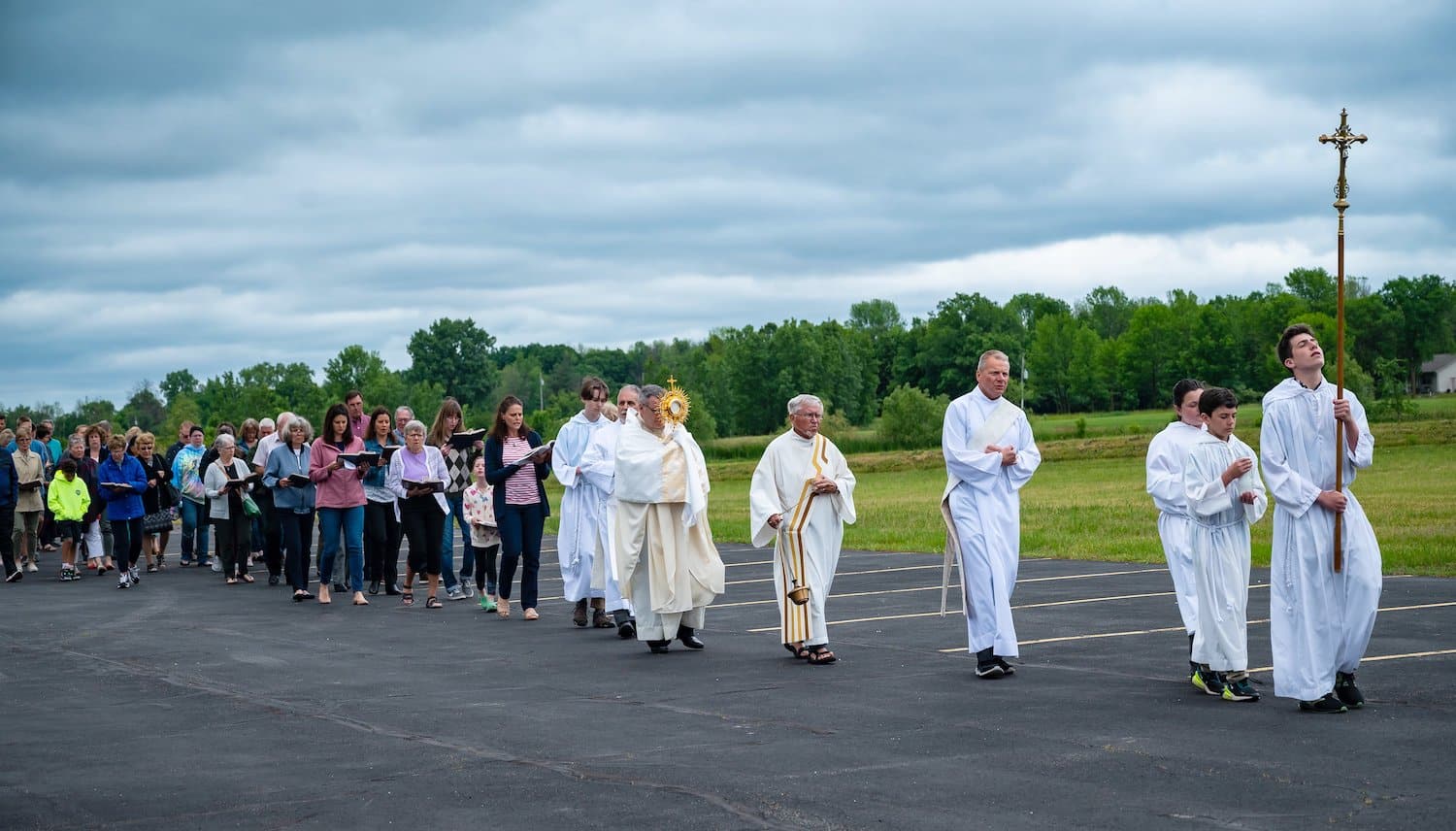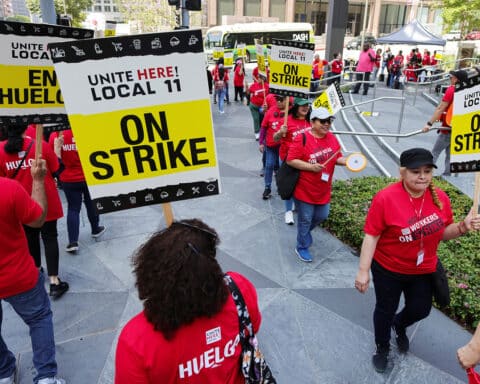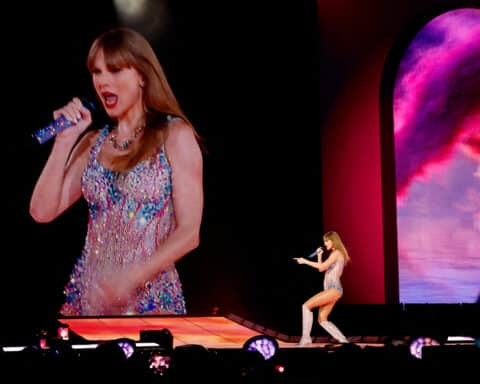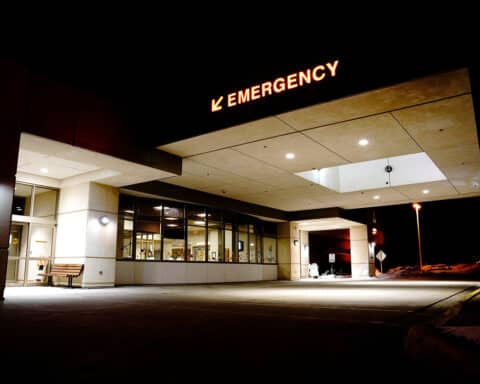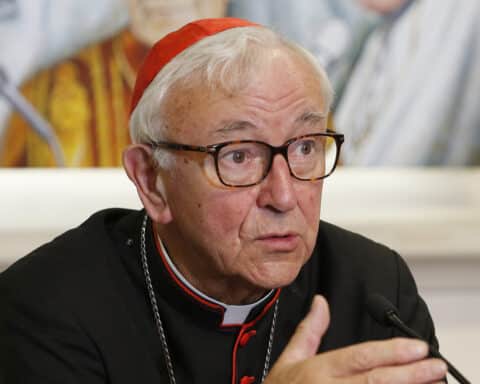(OSV News) — Over the centuries, the tradition of processing with the Eucharist through the streets on the feast of Corpus Christi has spread throughout the Catholic Church and become a revered tradition for Catholics all over the world.
“Corpus Christi” (“Body of Christ”) is the Latin name of the Solemnity of the Most Holy Body and Blood of Christ. In most U.S. dioceses, the feast day was celebrated June 11, and Eucharistic processions to mark the feast took place across the country in cities and towns, large and small.
This year, these public displays of devotion to the Real Presence in the Eucharist took on greater importance as the U.S. church’s three-year National Eucharistic Revival entered its second year, shifting its focus to parish renewal. The revival’s organizers expect this year will inspire more parishes to increase the Eucharist’s visibility in their communities.
“We offer here the most perfect worship that it is possible for human beings to give the Father, because we join Jesus in worshipping his Father,” Archbishop Allen H. Vigneron said during Mass June 11 at the Cathedral of the Most Blessed Sacrament in Detroit. “Let us resolve always to treasure the most holy Eucharist, that we would rather die than give up this opportunity to celebrate this life-giving manna.”
The faithful who filled the cathedral included members of the Knights and Dames of the Order of Malta, the Knights and Ladies of St. Peter Claver, and Knights of Columbus.
As Mass concluded — and before he led a Eucharistic procession out of the cathedral — Archbishop Vigneron placed the consecrated host into a monstrance, donning a short, cape-like vestment known as a humeral veil to cover his hands — a sign that it is Christ himself, rather than the minister, who blesses the people.
New York Auxiliary Bishop Joseph Espaillat, along with the pastors of the New York Archdiocese’s West Bronx Deanery, led nearly 2,500 people in Eucharistic procession along the Grand Concourse in the Bronx.
The four-hour procession along the boulevard was one of many such events held throughout the New York Archdiocese. It began at 4 p.m., starting at St. Philip Neri Church at 202nd Street and ending at Cardinal Hayes High School at 151st Street.
The faithful recited prayers of hope and sang songs of praise in Spanish and English, guided by priests, women religious, deacons and lay leaders.
Olga Rodriguez was among those walking in the procession. She was participating to help demonstrate to the world “that Jesus is alive, he is the sacrament on the altar,” Rodriguez told The Good Newsroom, the New York archdiocesan news outlet.
“He is everything for my family and for my friends,” Rodriguez, mother of two, said after the procession passed 199th Street. Her home parish is St. Anthony of Padua in the Bronx, where Bishop Espaillat is pastor.
Also in the procession was Rafael Cartagena, a parishioner at St. Margaret Mary in the Bronx. He said he was there “to support the church on this Corpus Christi Sunday. We are all with Jesus. In our lives, we need Jesus Christ; and with the way things are nowadays, the world needs Jesus Christ.”
About 1,400 people gathered outside St. Philip Neri Church before the procession began. Along the way, parishioners from several churches relatively close to the Grand Concourse joined, having been waiting at select corners of the concourse, swelling the numbers to nearly 2,500.
The participants, with police escort, walked on the southbound side section of the concourse, and on the adjacent sidewalks. Bishop Espaillat offered a blessing when the procession ended at Cardinal Hayes High School.
Organizers say the procession and other National Eucharistic Revival gatherings are testimonies of the Catholic faith, that they are certain that walking with the Eucharist in the procession is to bless the people of God, that the Lord is in the Eucharist, that “this is about shouting out, ‘God is with us,'” and that in the middle of all that is happening today in society, Eucharistic processions are “signs of hope.”
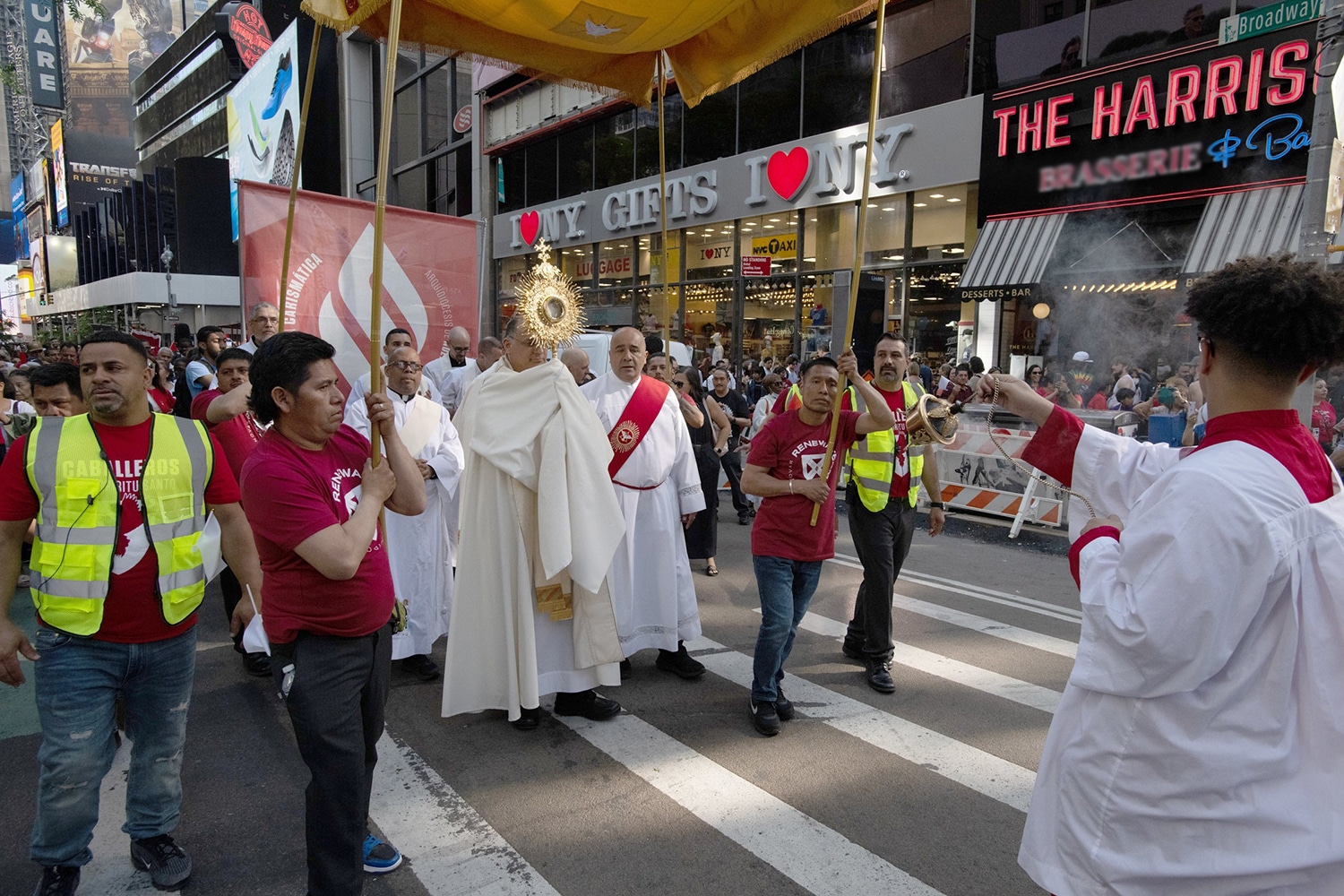
On May 27, a Spanish-English Pentecost vigil at St. Patrick’s Cathedral was preceded by a large street procession from Father Duffy Square at Times Square to the cathedral. Bishop Espaillat and members of the Charismatic Renewal of the Archdiocese of New York led that procession and the vigil.
A month earlier, still in the revival’s diocesan phase, West Virginia Bishop Mark E. Brennan reminded the faithful gathered for the second of three Wheeling-Charleton diocesan Eucharistic congresses that “it’s important that we understand what the Eucharist is. It is nothing less than Jesus Christ in person.”
“Do not let the appearances of bread and wine deceive you,” he told the congregation April 29 at the Cathedral of St. Joseph in Wheeling. “They do not change physically, but they do change in another way. In a mysterious way that I think we can describe but never explain, the Lord appropriates those physical elements — material elements of bread and wine — to his risen body so that when we receive holy Communion we are receiving his true body and blood, soul and divinity.”
In March, as part of the National Eucharistic Revival, with the Blessed Sacrament held high, Los Angeles Archbishop José H. Gomez of Los Angeles led more than 1,000 Catholics carrying flags, rosaries and an abundance of spirit out of Mission San Gabriel Arcángel and onto the streets of the San Gabriel Valley.
The event was unlike any other in the Archdiocese of Los Angeles’ history. “Hey, Christ is alive!” called out Teodora Magluyan, a parishioner of St. Luke the Evangelist Church, Temple City. “The power of God is so amazing. … This is my opportunity to tell the world.” Dozens of priests, sisters, and seminarians helped lead the March 25 procession.
In Portland, Maine, on Corpus Christi Sunday, the Eucharistic procession through that city’s streets prompted Steve, a patio patron at a local restaurant, to ask, “Any idea what this is?” — as he looked up from his sandwich and saw hundreds of parishioners approaching with the Blessed Sacrament.
“It’s Corpus Christi Sunday,” a passerby said. “It’s a procession from the church.”
“That’s pretty cool,” said Steve, who nimbly jumped on his chair, pulled out his iPhone, and began taking a video of the scene before him. “That’s amazing.”
He was hardly alone as diners, drivers, residents and tourists all stopped to take in the hundreds and hundreds of parishioners participating in a Corpus Christi Eucharistic procession through the streets of Portland.
Following a packed 10 a.m. Mass at the Cathedral of the Immaculate Conception, the Blessed Sacrament was placed in a monstrance, which was carried under a canopy amid the crowd for a nearly three-mile trek through the city, with stops at St. Peter Church, St. Louis Church and Sacred Heart Church.
The massive procession was led by a police cruiser and a pickup truck with an audio system. Clergy, cantors and choirs were next, with parishioners of all ages from the five different parishes following. A passenger bus pulled up the rear with parishioners who weren’t up for the long walk from church to church.
The sights and sounds of the procession were inspiring to the Catholics participating, but clearly affected those who took it in as some passersby stopped to shoot videos, others inquired about its purpose, and some started to pray.
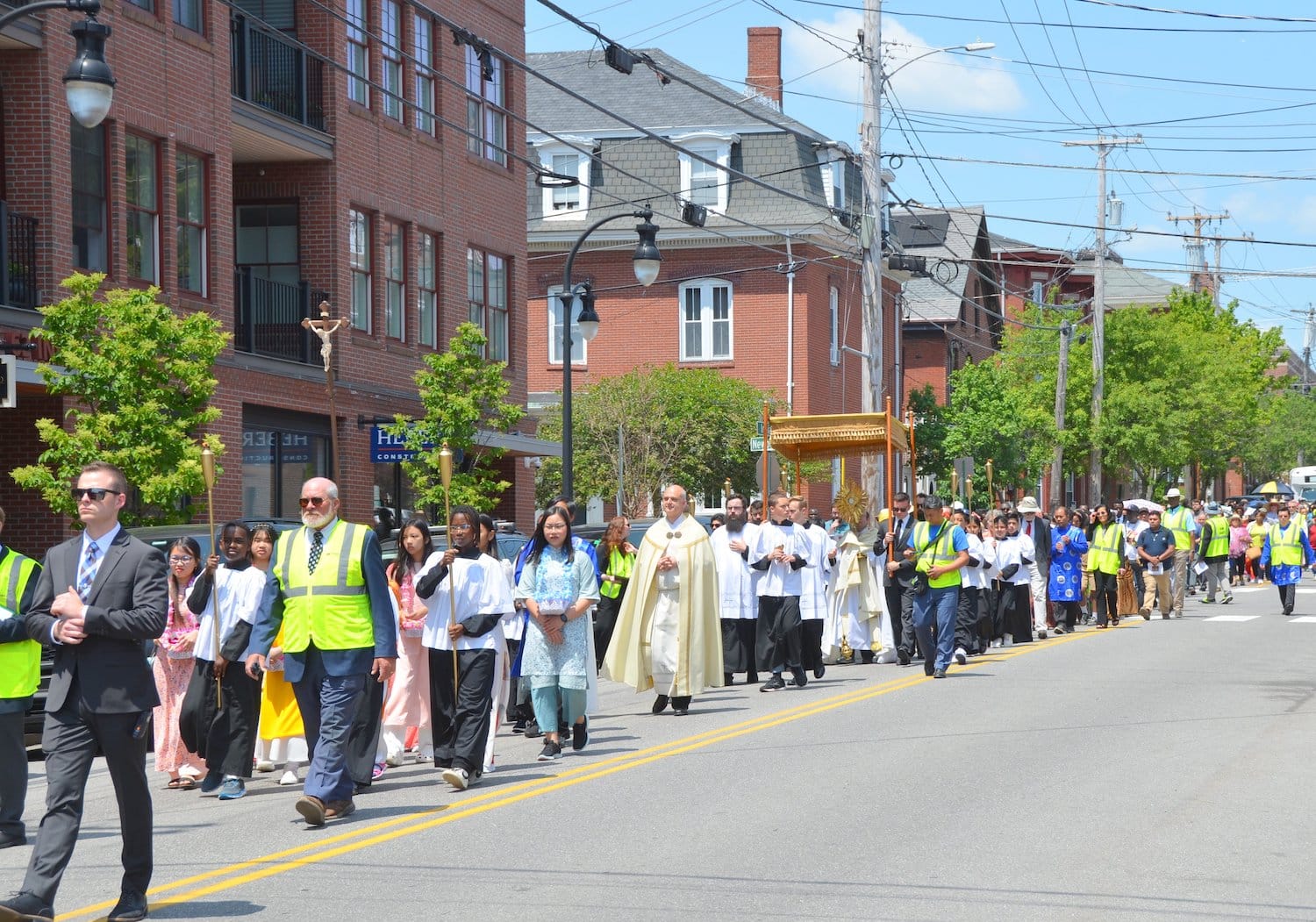
“The Eucharistic procession helps to remind Catholics that we all have a part to play in the Church,” said Father Seamus Griesbach, rector of the cathedral as well as pastor of four parishes. “We are not an audience watching Jesus go by, but we are a part of the procession of faith. It helps us to develop a deeper awareness of our community and the way that the Eucharist has brought us all together. The procession brings Catholics out of our churches and into our community, allowing our community to encounter the Church in a new way.”
He added, “Many people have only heard stereotypes and do not understand the diversity and vibrance of the Catholic Church. We hope that the procession showed our community this beautiful and positive side of our Catholic faith and helped them to see the positive presence that our churches are to this city.”
The procession also reflected the cultural diversity of the participating parishes, with groups of Vietnamese, Polish, Spanish and Italian, among others, intermingling along the route.
Across the country in Texas, following the Corpus Christi Mass at San Fernando Cathedral in San Antonio, scores of churchgoers and clergy processed with the Blessed Sacrament through downtown. With prayer and song in both English and Spanish, Catholics stopped at different altars along the way to adore Christ in the Eucharist. After the procession, the faithful went back to the cathedral to listen to songs by the Niños Cantores de Morelia, a children’s choir from Morelia, Mexico.
After the benediction, Archbishop Gustavo García-Siller thanked the faithful for their devotion to the Lord. He also thanked God for some breeze at the end of the procession on an evening when, according to weather reports, temperatures surpassed 90 degrees.
The archbishop said attendees recognize God as they adore him. “We know what is to receive his body and blood,” he said. “These are symbols, testimonies — we are giving witness in the middle of our city and the world with these acts of devotion.”
In the Diocese of Tucson, Arizona, the feast of Corpus Christi at St. Andrew the Apostle Church in Sierra Vista is one of the parish’s largest and most anticipated events of the year.
The parochial vicar, Father Samuel Jandeh, who is from Nigeria, carried the Blessed Sacrament under a 100-year-old processional canopy, acquired from the Benedictine Sisters after the closing of their Chapel of Perpetual Adoration in Tucson.
As the procession made its way around the block to the church’s Divine Mercy Chapel for adoration and benediction, participants joined in singing hymns with the choir.
Children in the Vacation Bible School made chalk drawings on the sidewalk route of the procession, while youth from the Life Teen program carried the processional banners.
Parishioners were invited to wear their own national dress or costume. Traditional attire from Korea, Vietnam, Mexico, Columbia, Germany, Scotland, Guam and Fiji was a visual proclamation of “Christ for the whole world!”
First communicants and representatives of the parish’s various apostolates and ministries joined in the procession, along with clergy, a Knights of Columbus honor guard, Knights and Dames of the Holy Sepulcher of Jerusalem, Franciscan Sisters of Christian Charity, and members of the Society of St. Vincent de Paul and the Legion of Mary.
In the Diocese of Arlington, Virginia, hundreds of families traveled to a county fairground in Front Royal for a June 10 festival that kicked off with a vigil Mass for the feast of Corpus Christi celebrated by Bishop Michael F. Burbidge.
In his homily, Bishop Burbidge shared that he recently had given his grand-niece her first holy Communion. “Right after Mass she said, ‘This is the happiest day in my entire life.’ That is the profound gratitude all of us should have,” he said.
“We pray that in our diocese and in our lives, the Eucharist will be firmly believed, devoutly received and intensely lived so that we will one day be a heavenly family where we dwell with God forever and ever,” Bishop Burbidge said. “Let’s promise to share our belief in and love for the Eucharist with others.”
Parish leaders seeking guidance for the National Eucharistic Revival’s parish-focused year that began June 11 have a 24-page resource available to them here. The “Leader’s Playbook,” released May 1, helps parishes answer the question “what are we being asked to do?” through four “invitations” for the Year of Parish Revival.
Contributing to this story was the Detroit Catholic, online news outlet of the Archdiocese of Detroit; Armando Machado of The Good Newsroom, online news outlet of the Archdiocese of New York; Colleen Rowan, executive editor of The Catholic Spirit, newspaper of the Diocese of Wheeling-Charleston; Angelus, online news outlet of the Archdiocese of Los Angeles; Dave Guthro, communications director for the Diocese of Portland; New Outlook, online news outlet of the Diocese of Tucson; and Zoey Maraist, staff writer at the Arlington Catholic Herald, newspaper of the Diocese of Arlington.

